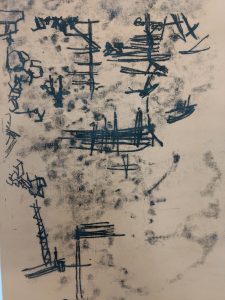For this task I decided to appropriate the work of Julie Mehretu and William Kentridge to create my own original artworks. The aspects I like most about Mehretu’s and Kentridge’s work are the use of mark making, even though their styles are completely parallel to each other. Mehretu utilisés a lot of detail in her work, this comes in the form of what looks like architectural blueprints, giving an immense sense of complexity within each piece. However this is juxtaposed by the use of layered marks which are much more abstract and free. This creates a visually interesting image. On the other hand Kentridge uses very rough emotive marks to create a visual tension, this being effective when animating and bringing his drawings to life.
How I appropriated these artist’s works was through the use of mono printing. After scanning and printing images of the artist’s that I like I was able to pick certain lines that grabbed me through a very instinctive process. The final outcome of this process created abstract pieces of work that combined the straight rigid linework of Mehretu and the emotive marks of Kentridge, again creating an interesting juxtaposition. To develop this further I also used collage to combine the two artist’s works. I believe they work well together because of the lack of colour which is a similar aspect of both of their drawing’s.
By using this process I was able to visually analyse both of the artist’s works and compare the similarities and differences between them.
Bibliography-
Kentridge, W. and Christov-Bakargiev, C., 2004. William Kentridge. Milano, Italy: Skira.
Mehretu, J., 2013. Julie Mehretu. New York: Marian Goodman Gallery.




